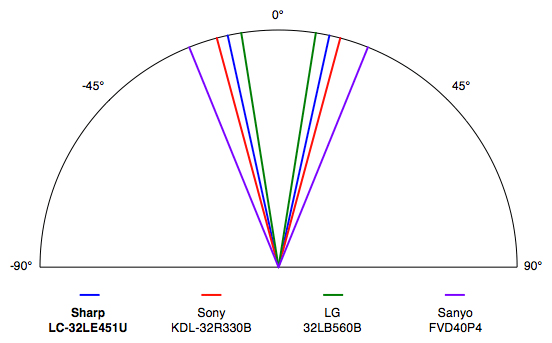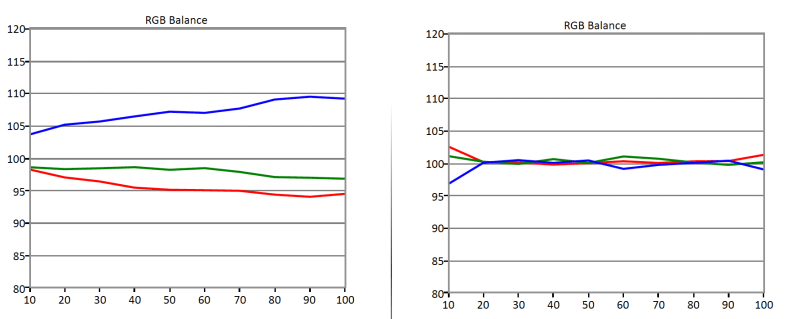Initially, we were convinced of this TV's value—and, even for a 720p TV, it's not a bad choice for casual or even more serious viewers—but it's ultimately outclassed by the competition.
If you're a Blu-ray lover or game all day on a current-gen console, you're better off spending a little more on Sharp's entry-level Full HD (1080p) option, the LE551U. If you're aiming to get the best price possible and don't mind a lower resolution, Sony's R330B is the better performer.
Design & Usability
You wouldn't call this a premium experience, but it works.
When it comes to entry-level TVs, the 32-inch LE451U is a little above average in the looks department. Smooth black plastic yields narrow bezels, an angular rear casing, and a minimalist stand. The panel is quite thin at its edges, and rests sturdily upon a flat, pedestal base. Overall, this TV looks good for its price, but won't turn many heads.

The LE451U is sturdy and fitted with modern trimmings, but it won't turn too many heads, either.
You'll find audio/video ports arranged along the side and back of the panel. Side ports include one HDMI input, a USB 2.0 port, and an analog/stereo output; coaxial, composite, component, digital audio, and a second HDMI input live directly on the back. You'll find the on-set controls (power, volume, channel selection) hidden back here, too.

Ports include two HDMI inputs, a USB 2.0 input, analog/digital audio options, and a component/composite cluster.
Sharp includes a very standard, cheap-feeling remote control with this TV. The remote isn't anything special, but it works well enough as long as you're pointing right at the TV. If you stray too far horizontally or vertically with your inputs, however, the response gets dodgy.

The included remote is simple, but it's equal to all tasks as long as you point it right at the screen.
The TV's audio quality is a bit disappointing: the two down-firing 10-watt speakers can sound tinny, as their bass frequencies aren't bouncing off of the table to your ears effectively. Fortunately, if you really don't like them, the analog/digital audio ports mean you can sub in an external solution.

The hollow plastic stand looks nice, but is very lightweight and cheap. That could be a good or a bad thing, I suppose.
Don't expect to be blown away by the software menus, either. This isn't a smart TV, so all you get are the basics for Picture/Audio/System setup. Sharp at least includes a 2-point white balance control, so you picky picture purists can (sort of) correct the TV's color temperature if you're so inclined.

The menu software is plain, but still offers a couple of advanced controls like 2-point white balance. Just don't expect things to look pretty.
Picture Quality
A plus and minus game.
Like most entry-level TVs, the Sharp LC-32LE451U is not without a few flaws. Fortunately, it has a number of strengths that counteract these drawbacks as long as you're utilizing them properly. Testing revealed that, even though this is a 720p (1,366 x 768 resolution) TV, it handled 1080p cinematic content pretty well.
I watched a number of scenes from The Dark Knight on Blu-ray, and found that this Sharp, first and foremost, boasts solid contrast performance. Shadow tones (black levels) are satisfyingly dark, and the backlight uniformity is great for an edge-lit LED TV.
The LE451U achieves plenty of luminance, too, though it's best-suited to a room with little to no competing ambient light.
One reason we say this is because the TV's Movie mode introduces very little artificial processing, making for a clean picture that preserves subtle details.
On the other hand, the TV's Dynamic mode—meant for bright rooms—does the exact opposite, introducing ugly picture artifacts and garrish colors.

Thanks to its deep shadow tones and high contrast, the LE451U is well-suited to cinematic content with emphasis on dynamic range.
Likewise, I found that fast-paced scenes were easy on the eyes. The LE451U is only a 60 Hz panel, however, meaning it refreshes at a maximum of 60 times per second—the bare minimum by today's standards. Interlaced content (like 480i or 1080i) can suffer from jaggies and stuttering at times, but only during the most demanding sequences.
If there's one notable issue that might put off dedicated viewers, it's the TV's color accuracy. Testing revealed that green hues are a bit oversaturated, and that red hues tend towards an orange-ish cast—the former isn't too distracting, but the latter can be.
For example, during the bank robbery in The Dark Knight, William Fichtner's face looked like he'd been spending a little too much time with The Situation down at the Jersey Shore.

Skin tones with a slightly reddish hue take on a mildly orange cast, which is pretty distracting when it's front and center.
The LE451U gives users access to a 2-point (High/Low) white balance control, but no Color Management System, so we couldn't see how the TV looked with better color accuracy post-calibration.
The last thing that might put you off this TV is its resolution. At 32 inches, it's just big enough that the 720p resolution may look thin/stretched out if you're watching very attentively. Scenes with lots of details occasionally look a little fuzzy/pixellated, though it's a only a problem if you plan to sit closer than five feet.

Because of its 720p native resolution, the LE451U occasionally looks a little blocky/pixelated while playing back 1080p content via Blu-ray or game console.
The issues with color accuracy and thin resolution are only notable problems if you're watching highly detailed content like Blu-ray discs. On the other hand, the TV's biggest strength—contrast—is not as striking nor as important during more heavily compressed content via cable, satellite, or Netflix.
Want to check out all of our test results and fancy charts? Head to this TV's Science Page.
The Verdict
Not a bad buy, but it's narrowly bested by the competition.
The 32-inch LE451U is hard to ignore, especially with online prices as low as $229. That's a solid bargain for a TV in this size class, especially one that's capable of such good contrast and screen uniformity.
At 720p native resolution, however, this Sharp is a little behind the times, especially for power users. If you're an Xbox One or PlayStation 4 owner, you should aim for something that's 1080p like the Sharp LC-32LE551U, the series one step up from this one.
At the end of the day, however, even if you're just searching for a solid 720p TV for cheap, the LE451U is not the best choice. Sony's 32-inch R330B is a better performer in almost all aspects, and it's also a little cheaper. The Sharp LC-32LE451U (MSRP $269.99, online as low as $229.99) is a decent performer, but is equal parts good and bad considering all use cases.
For its price, the LE451U delivers solid contrast (bright/dark) performance, up there with pricier LED TVs, and has some of the best backlight uniformity we've seen in this size class.
Unfortunately, it also struggles to produce wholly accurate red and green primary colors, which create some issues when dealing with highly detailed content.
Calibration
We calibrate each TV we test for two reasons. The first reason is that calibration gives us the best idea of exactly how a TV performs, from its RGB channel emphasis to its horizontal viewing angle. The second reason is to see how close it can match the international standards after a full, professional calibration.
This Sharp made the calibration process a little more interesting than usual by providing a 2-point white balance (grayscale) correction menu, but did not supply a gamma slider, CMS (Color Management System), or multipoint grayscale controls, meaning we could only correct one aspect of its out-of-the-box error. Below, you'll find the default settings for the LE451U in the Movie picture mode alongside our final calibration settings.

Contrast Ratio
Contrast, or the difference between light and dark elements on-screen, is perhaps the keystone of a lifelike, immersive picture. No matter how big, small, cheap, or bank-breaking a TV is, it needs at least a moderately wide contrast ratio to look its best. To determine contrast ratio, we divide a TV's peak/reference white (100 IRE) by its black level (0 IRE) using a standard ANSI checkerboard pattern.
The LE451U boasts good contrast, offering up a dark black level of 0.034 c/m2 and a peak brightness of 105 cd/m2 in Movie mode. This is an excellent black level for an edge-lit LED TV in this price range. While it's not the brightest output, you can always notch the Backlight control up a few clicks to hit closer to 120 cd/m2, which is nominal brightness for most normally lit environments. The LE451U's overall contrast ratio is 3089:1, which is ample.

Viewing Angle
Our horizontal viewing angle test measures how far from one side or the other you can watch a TV before the picture's contrast drops below 50% of its head-on value. Essentially, as you move away from head-on viewing, LCD (LED) TVs like this one tend to look worse and worse, with shadows turning gray and colors shifting.
For its size, the LE451U is not the strongest performer: I measured a total viewing angle of 25°, or ±12.5° from the center to either side of the screen. Compare that to the three competing TVs, who offered total viewing angles as high as 44°.

Color Gamut
A color gamut is a visual illustration of a display's hue/saturation for its primary colors, secondary colors, and white point. HD TVs ought to produce color that falls in line with a set of requirements colloquially referred to as Rec. 709. Televisions with accurate color present content like TV shows and movies in a way that's mathematically matched to information supplied to them, helping to preserve and highlight valuable details.
The LE451U is not the strongest performer in terms of color accuracy, though we've seen much worse in this price range. The TV's biggest error is that it tends to produce reds with a little too much orange, owing to an oversaturated green point that, in turn, forces a higher visibility and emphasis on yellow. Mix red and yellow, and you get orange—voila. Because the LE451U lacks a Color Management System or color tuner controls, we couldn't fix this during the calibration process.

Grayscale & RGB Balance
Because TVs use additive color, they produce neutral tones (whites, grays, etc.) by combining their three primary colors: red, green, and blue. When these colors are emphasized evenly, grayscale elements appear color-free and vibrant. When these colors aren't emphasized properly, grayscale elements can take on ugly tints like peach or cold blue, or can look somewhat dirty and poorly lit.
Such visible error within the grayscale is measured in a collective called DeltaE, where a DeltaE of 3 or less is considered acceptable within the industry. By default, the LE451U tested with a grayscale DeltaE of 9.31, which is a good bit higher than we'd like to see. Even using the TV's 2-point white balance (grayscale) control, we were only able to reduce the DeltaE to 7.98, which is still too high.

If we check out the TV's underlying RGB emphasis, we can see where most of the error arises. Out of the box, the LE451U heavily emphasizes the blue channel at the expense of red and green. This introduces a cool, blue-ish tint to grayscale elements. While we were able to slim down disparities between the RGB channels using the TV's 2-point white balance control, the errors were still present in much of the signal.

Gamma
If contrast refers to the highest high and lowest low of a TV's luminance, gamma can be said to represent the middle tones. Traditionally, TVs (and all displays) adhere to certain gamma standards depending on the amount of light they're competing with in the room. Gamma standards run from 1.8, 2.0, 2.2, to 2.4, with bigger numbers representing more gentle progressions out of the black level into shadow details and nuanced midtones. During calibration, we aim for a gamma of 2.4, which is roughly equivalent to Hollywood's BVMs.
The LE451U tested with a gamma of 1.94, though the majority of its curve follows the 2.2 standard—it simply cuts off too early, glossing over highlight details between 90 IRE and 100 IRE. This isn't a huge issue, but it does mean the total gamma is not as it should. Lacking a gamma slider or a gamma multipoint control, the gamma stayed roughly the same after our calibration process.

Meet the tester
Lee was Reviewed's point person for most television and home theater products from 2012 until early 2022. Lee received Level II certification in TV calibration from the Imaging Science Foundation in 2013. As Editor of the Home Theater vertical, Lee oversaw reviews of TVs, monitors, soundbars, and Bluetooth speakers. He also reviewed headphones, and has a background in music performance.
Checking our work.
Our team is here to help you buy the best stuff and love what you own. Our writers, editors, and experts obsess over the products we cover to make sure you're confident and satisfied. Have a different opinion about something we recommend? Email us and we'll compare notes.
Shoot us an email

